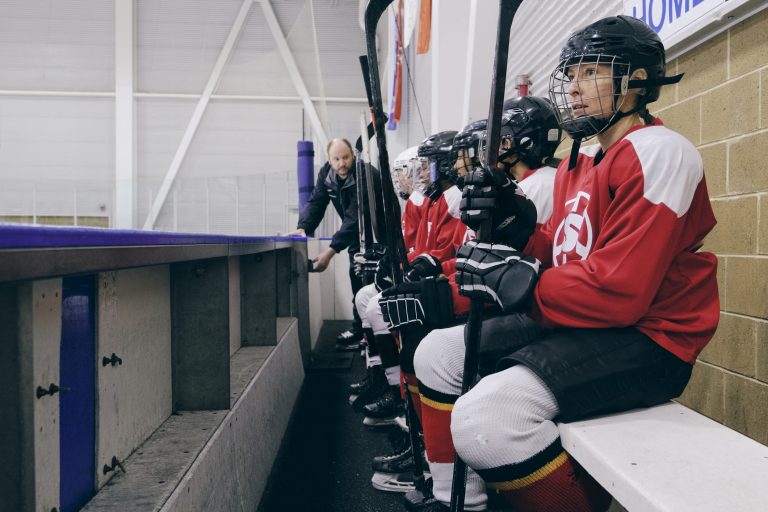A bag of sweaty hockey equipment is like a Holiday Inn for bacteria.
When the zipper closes, it creates a damp, dark environment where bacteria will thrive, resulting in the pungent, unpleasant smell that hockey parents know so well. (Sorry to be the one to tell you, but as your young player enters the tween and teen years, it only gets worse!)
I play hockey myself and have many hockey-parent friends, so I’ve compiled their best tips for washing hockey gear and keeping it as clean and odor-free as possible.
Moisture is Your Opponent
The number one tip was unanimous: dry it out. Immediately following each game or practice, every piece of equipment should be removed from the bag and hung up (or at least spread out) to dry.
To facilitate this process, I purchased a metal “tree” style rack with rods that hold various pieces of equipment and allow air to circulate through them. Other families proudly shared their designs for do-it-yourself wooden versions they had built themselves and placed in the basement near a heating vent or fan. Parents of rep hockey players who travel to out-of-town tournaments favored a coat-hanger inspired system, noting that it was especially handy to air out wet gear in the hotel room between games.
To counteract the smell, some families experimented with mainstream laundry products such as fabric softener sheets (placed in the empty bag as a deodorizer) and household odor eliminator sprays (applied directly to the gear). A variety of sport-specific antimicrobial products also came highly recommended, including Norwex Sportzyme spray, Captodor Sport spray and GearHalo SilverACTIV deodorizer pods.
Cleaning Play-by-Play
When it comes to washing and disinfecting a typical set of player equipment, let’s work from the top down.
Helmet
Use an antibacterial wipe on the interior padding, the inner side of the mask or cage, and the chin pad. Dry with a towel or set aside to air-dry.
Neck guard, shoulder pads and elbow pads
Pull out any removable inserts, if applicable. To avoid snags and tangles, check that all the Velcro tabs are properly closed. Place in the washing machine and run a standard cycle with cold or warm water. Use regular detergent but do not add bleach. Remove the pieces from the washing machine as soon as it beeps and hang to dry.
Team jersey
This may be an expensive, difficult-to-replace item with a custom crested logo, so handle with care. Wash in cold water (to prevent the colors from bleeding) and hang to dry.

Undershirt and other “base layer” pieces
Washing hockey gear isn’t just about the gear- you need to consider the base layers too. This category includes any clothing that is worn underneath the gear and comes in direct contact with the skin: underwear, undershirt, tights, socks, jock or jill shorts, and so on. These should all be washed with the regular laundry after every session. For particularly “fragrant” clothing, consider using your machine’s pre-soak or extra rinse settings. Since these pieces are often made from technical fabrics to wick away moisture, check the manufacturer’s tag for any special washing or care instructions.
Gloves
By all accounts, these are often the stinkiest pieces of equipment. The sprays mentioned above were popular to help keep unwanted odors at bay. Gloves can be machine-washed, although they definitely can’t go in the dryer because of the leather material in the palms. Instead, place them upright on a boot or mitten drying rack, positioned over a heating vent.
Pants and shin pads
These are bigger pieces that might not be practical to wash regularly during the season, as they take longer to air-dry. The good news is, wearing a base layer helps absorb sweat and keep moisture away from the pads themselves. If needed, these items can be washed in the machine as well – just keep the load small to give them adequate space.
Skates
These obviously can’t go in the washing machine, but you can speed up the drying process by removing the insoles at the bottom of each skate. Just remember to replace them when re-packing the bag!
Speaking of the bag, don’t forget to sanitize it, too. Wipe down the interior with an antibacterial wipe and dry thoroughly.
Game Strategy
Your role as equipment manager will require some proactive scheduling, since anything you wash will need an appropriate amount of time to dry. Of course, that might not be possible if your young all-star has a full schedule of practices and games. If you prefer to wait until the off-season for washing hockey gear in full, take advantage of the nicer weather and set it outside to dry in the sun.
If you have the desire (and budget) to delegate this task to someone else, do an online search for drop-off gear cleaning companies in your area. Your city’s hockey arena or community centre may offer this type of service or can direct you to a local business.
Ultimately, the goal is to prevent bacteria from checking in for a long-term stay in your child’s hockey bag. Even though it’s probably the last thing you feel like doing, you’ll be glad you took a few extra minutes to unpack and hang up the gear. And, if something doesn’t pass the “smell test,” you know what to do.
Another task of equipment manager (aka parents) is making sure that all your gear is properly labeled. Here are two great options from Mabel’s Labels that will ensure that your equipment gets back in the right hockey bag.
Kids’ Recreation Sports Label Pack: Waterproof, sweatproof and ideal for house league and rec sports! This label pack has 12 fun sports icons to choose from.
Kids’ Competitive Sports Label Pack: These are perfect for kids in competitive sports. It includes enough labels for uniforms, jerseys, equipment & more. In addition, this pack has new options for team colors and jersey numbers!
Good luck and have a great season!
If you’re new to the world of Hockey, check out this post for more tips

